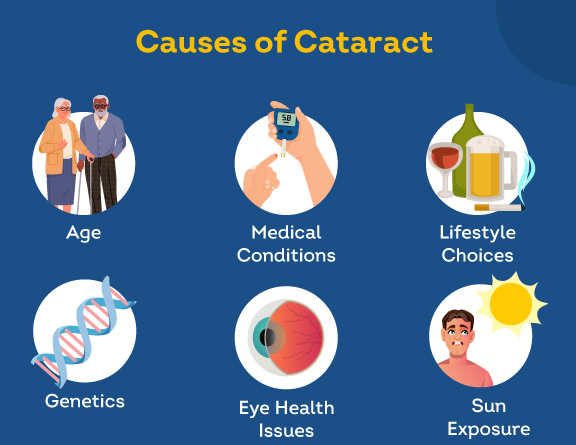
Select City
Cerulean cataract is a rare congenital condition characterized by blue-white opacities in the lens. This age-related condition, affecting infants and adults, progressively impairs vision. With modern techniques, such as micro-incision phacoemulsification and laser-assisted surgery, the cloudy lens can be successfully removed and replaced with an artificial intraocular lens. If you suspect you or your child may be affected by a cerulean cataract, reach out to a Pristyn care doctor for an expert consultation. Book your appointment today with our expert ophthalmologist for comprehensive cerulean cataract management.
Cerulean cataract is a rare congenital condition characterized by blue-white opacities in the ... Read More




Free Consultation

Free Cab Facility

No-Cost EMI

Support in Insurance Claim

1-day Hospitalization

USFDA-Approved Procedure
Cerulean cataract surgery is a specialized procedure performed to treat individuals suffering from cerulean cataracts. This type of cataract presents from birth or early childhood with unique blue-white opacities in the lens arranged in concentric layers. When these cataracts significantly impact visual acuity, cerulean cataract surgery is recommended.
The surgery involves removing the cloudy lens and replacing it with an artificial intraocular lens (IOL). An eye doctor (ophthalmologist) carries out this operation on an outpatient basis, meaning hospitalization is not necessary post-surgery. Cerulean cataract surgery has a high success rate and offers significant improvement in vision, making it a practical choice for cerulean cataract management.

Fill details to get actual cost
Identifying the need for a cerulean cataract surgery requires a thorough diagnosis. Your family physician or ophthalmologist will typically conduct a series of tests and evaluations as detailed below:


Cerulean cataract surgery is generally done between the second and fourth decade of life unless it significantly impacts vision at an earlier age. Here is an insight into the surgical procedure:
Determining the right candidate for cerulean cataract surgery is based on a holistic assessment of an individual’s visual impairment, especially in adults, and its impact on everyday life. Although every case is unique, some common eligibility factors include:
Impact on Daily Life: Surgery is considered when cataracts hinder daily activities like reading, driving, or working.
Diet & Lifestyle Consultation
Post-Surgery Follow-Up
Free Cab Facility

24*7 Patient Support
Cerulean cataract surgery is a speciality procedure that can greatly enhance an individual’s quality of life by improving their vision. Here are some key benefits:
Preventing Progression: Cerulean cataract surgery can halt the progression of cataracts, particularly where visual acuity is compromised, thus safeguarding the patient’s ability to see clearly as they age.
Before undergoing cerulean cataract surgery, certain steps need to be taken to ensure your readiness:
Recovery from cerulean cataract surgery can be a straightforward process if guidelines are followed diligently:
While cerulean cataract surgery is generally a safe procedure, like all surgeries, it carries some potential risks:
Cerulean cataract surgery is a crucial procedure that has helped numerous individuals regain the gift of sight. While this may appear quite steep, keep in mind that the price tag is significantly influenced by various factors, including:
Most insurance plans in India do cover cataract surgery. However, your coverage’s extent would depend on your specific plan and provider. Government-sponsored insurance schemes help to cover these surgeries in impanelled hospitals. Meanwhile, private insurance plans might also include cataract surgery coverage, but they often have caps on the reimbursable amount or lengthy waiting periods before coverage can be activated.
Pre-existing conditions, including cerulean cataracts, may face exclusions or longer waiting periods from your coverage. Co-payments, where patients are responsible for a portion of the costs, are also commonplace under many insurance schemes. Furthermore, premium lens types like multifocal or toric lenses might not be fully covered under insurance plans and could require additional out-of-pocket expenses from the patient. Therefore, it is crucial to thoroughly examine your insurance plan’s inclusions and exclusions and understand what part of your cerulean cataract surgery cost will be covered. Securing pre-authorization from your insurer before the surgery is also often necessary.
Hence, being informed and prepared can help manage the costs associated with cerulean cataract surgery effectively. It is always wise to discuss your financial options with your family physician or surgeon beforehand to avoid any surprises.
Cerulean cataract surgery age varies, as this condition can affect individuals at different stages of life, from infants to adults. However, it is commonly performed in adulthood when the cataract has advanced causing significant visual impairment.
Yes, cerulean cataract surgery in infants is possible and often necessary. Infants born with cataracts require early intervention to prevent lifelong visual impairment. However, it is a complex procedure and should be performed by highly experienced doctors.
Whilst the objective of cerulean cataract surgery remains the same for adults and infants, the surgical approach and aftercare might slightly differ due to physiological differences between these age groups.
Yes, rubella syndrome can cause a type of congenital cataract known as cerulean rubella cataract. If diagnosed, this typically necessitates prompt surgical intervention to safeguard the child’s vision.
Cerulean cataract management involves both non-surgical and surgical methods. Initially, changing your eyeglass prescription could help improve vision. However, when the cataract significantly interferes with daily activities, surgery becomes necessary.
While the basic procedure is similar to other types of cataract surgeries, there might be specific considerations during cerulean cataract surgery due to the unique nature of this type of lens opacity.
Usually, patients experience a significant improvement in vision post-crulean cataract surgery. However, the extent to which vision is restored depends on individual cases and the presence of any other eye conditions.
Certain practices like wearing UV protection sunglasses, maintaining a balanced diet rich in antioxidants, and avoiding smoking can slow the progression of cataracts, potentially delaying the need for surgery.
You can expect to return to your daily routines within a few days after cerulean cataract surgery. However, be sure to follow your doctor’s advice regarding activity limitations and eye care precautions.
Post-surgery, you will need to use prescribed eye drops, avoid strenuous activities, keep your eye protected, and attend regular follow-up visits to monitor healing.